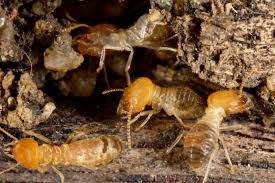How Much Does Termite Control Cost Can Be Fun For Anyone
Termites are eusocial insects which are categorized in the taxonomic rank of infraorder Isoptera, or as epifamily Termitoidae within the cockroach order Blattodea. Termites were once classified in a separate sequence from cockroaches, but recent phylogenetic studies indicate that they evolved from near ancestors of cockroaches during the Triassic.
About 3,106 species are currently clarified, using a few hundred more left to be clarified. Although these insects are often called"white ants", they are not ants. .
Like ants and some bees and wasps from the separate purchase Hymenoptera, termites split labour among castes consisting of sterile male and female"workers" and"soldiers". All colonies have fertile men called"kings" and one or more fertile females known as"queens". Termites mostly feed on dead plant material and cellulose, generally in the kind of wood, leaf litter, soil, or animal dung.

The 9-Minute Rule for How Much Does Termite Control Cost
Termites are among the most successful groups of insects on Earth, colonising many landmasses except Antarctica. Their colonies range in size from a few hundred individuals to enormous societies using many million individuals. Termite queens have the longest lifespan of any insect in the world, with a few queens reportedly living up to 30 to 50 decades.
Colonies are called superorganisms since the termites form part of a self-regulating entity: the colony itself. .
Termites are a delicacy in the diet of several human civilizations and are employed in many traditional medicines. Several hundred species are economically significant as insects which can cause considerable damage to buildings, crops, or plantation forests. Some species, like the West Indian drywood termite (Cryptotermes brevis), are considered as invasive species. .

How Much Does Termite Control Cost Fundamentals Explained
The infraorder name Isoptera comes from the Greek words iso (equivalent ) and ptera (winged), which refers to the nearly equivalent size of the fore and hind wings.2"Termite" derives from the Latin and Late Latin word termes ("woodworm, white ant"), modified by the influence of Latin terere ("to rub, wear, erode") from the prior word tarmes.
The external appearance of the giant northern termite Mastotermes darwiniensis is suggestive of the intimate relationship between termites and cockroaches.
Termites were formerly put in the order Isoptera. As early as 1934 suggestions were made they were closely linked to wood-eating cockroaches (genus Cryptocercus, the woodroach) based on the similarity of the symbiotic gut flagellates.6 In the 1960s additional evidence supporting that theory appeared when F. A. McKittrick noted comparable morphological characteristics between a number of termites and Cryptocercus nymphs.7 In 2008 DNA analysis from 16S rRNA sequences8 affirmed the position of termites being nested within the evolutionary tree containing the order Blattodea, which included the cockroaches.910 The cockroach genus Cryptocercus stocks the strongest phylogenetical similarity with termites and is considered to be a sister-group to termites.1112 Termites and Cryptocercus share similar morphological and social features: for example, most cockroaches do not display societal characteristics, but Cryptocercus takes good care of its young and displays other social behavior such as trophallaxis and allogrooming.13 Termites are thought to be the descendants of the genus Cryptocercus.914 Some investigators have suggested a more conservative measure of retaining the termites since the Termitoidae, an their explanation epifamily within Get the facts the cockroach order, which averts the classification of termites at family level and below.15 Termites have long been accepted to be closely associated with cockroaches and mantids, and they're classified in the exact same superorder (Dictyoptera).1617.
The oldest unambiguous termite fossils date to the early Cretaceous, but given the diversity of Cretaceous termites and early fossil records showing mutualism between microorganisms and such insects, they likely originated before in the Jurassic or Triassic.181920 Further evidence of a Jurassic origin is that the assumption that the extinct Fruitafossor consumed termites, judging from the morphological similarity to modern termite-eating mammals.21 The earliest termite nest discovered is thought to be by the Upper Cretaceous in West Texas, where the earliest known faecal pellets have been also discovered.22 Claims that footprints arose previously have faced controversy.
Excitement About How Much Is Orkin Termite Control
Weesner indicated that the Mastotermitidae termites may return to the Late Permian, 251 million years ago,23 and fossil wings which have a close resemblance to the wings of Mastotermes of the Mastotermitidae, the most primitive living , have been found in the Permian layers in Kansas.24 it's even possible that the first termites emerged during the Carboniferous.25 The folded wings of this fossil wood roach Pycnoblattina, arranged in a convex pattern between segments 1a and 2a, resemble those seen in Mastotermes, the only living insect with the same pattern.24 Krishna et al., however, consider that each one of the Paleozoic and Triassic insects tentatively classified as termites are in fact unrelated to termites and needs to be excluded out of the Isoptera.26 The primitive giant northern termite (Mastotermes darwiniensis) exhibits numerous cockroach-like attributes which are not shared with other termites, like laying its eggs in rafts and having anal lobes on the wings.27 Cryptocercidae and Isoptera are united in the clade Xylophagidae.28 Termites are sometimes called"white ants" but the only resemblance to the ants is because of their sociality that's because of convergent evolution2930 with termites being the first social insects to evolve a caste system more than 100 million years ago.31 Termite genomes are generally comparatively large in comparison to that of other insects; the first fully sequenced termite genome, of Zootermopsis nevadensis, that was published in the journal useful content Nature Communications, consists of roughly 500Mb,32 while 2 subsequently published genomes, Macrotermes natalensis and Cryptotermes secundus, are considerably larger at around 1.3Gb.3330.